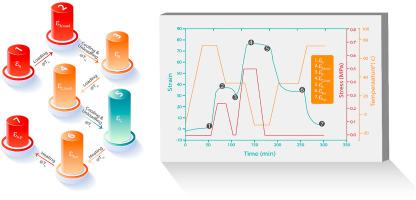当前位置:
X-MOL 学术
›
Compos. Commun.
›
论文详情
Our official English website, www.x-mol.net, welcomes your
feedback! (Note: you will need to create a separate account there.)
Designing a polymer blend nanocomposite with triple shape memory effects
Composites Communications ( IF 6.5 ) Pub Date : 2021-02-01 , DOI: 10.1016/j.coco.2020.100564 Mohammad Amini , Shuying Wu
Composites Communications ( IF 6.5 ) Pub Date : 2021-02-01 , DOI: 10.1016/j.coco.2020.100564 Mohammad Amini , Shuying Wu

|
Abstract In this work, a polymer blend nanocomposite containing two widespread natural biopolymers (poly (l-lactic acid) and polyvinyl acetate) and nanohydroxyapatite (nHA) was manufactured. Triple-shape memory behavior was observed when 10 wt.% of nHA was incorporated to the polymer blends. In contrast, adding lower content of nHA (1 and 5 wt.% of nHA) did not bring about this behavior but only led to an increase in glass transition temperature (Tg). The triple-shape memory behavior was attributed to the phase separation in the polymer nanocomposites, which was confirmed by Atomic Force Microscope (AFM) and Dynamic Mechanical Analysis (DMA). The thermal responsive dual- and triple-shape memory behavior was thoroughly examined. According to the DMA results, the addition of nHA improved the thermal stability of nanocomposites, which in turn led to an increase in storage modulus. Subsequently, the results of the shape memory test indicated that the interaction between the matrix and the nanofiller could improve the shape memory properties of the nanocomposites. However, further increasing the nanofiller content (e.g., to 15 wt.%) led to formation of aggregation in the polymers and consequently degraded shape recovery ratio. Further research also demonstrated that increasing thermomechanical cycles had a significant effect on shape memory behavior. In other words, there is a synergistic effect of adding nanofiller and increasing thermomechanical cycles on improving the shape memory properties.
中文翻译:

设计具有三重形状记忆效应的聚合物共混纳米复合材料
摘要 在这项工作中,制造了一种包含两种广泛使用的天然生物聚合物(聚(l-乳酸)和聚醋酸乙烯酯)和纳米羟基磷灰石 (nHA) 的聚合物共混纳米复合材料。当 10 wt.% 的 nHA 掺入聚合物共混物时,观察到三重形状记忆行为。相比之下,添加较低含量的 nHA(nHA 的 1 和 5 重量%)不会导致这种行为,而只会导致玻璃化转变温度 (Tg) 的增加。三重形状记忆行为归因于聚合物纳米复合材料中的相分离,原子力显微镜 (AFM) 和动态力学分析 (DMA) 证实了这一点。彻底检查了热响应双重和三重形状记忆行为。根据 DMA 结果,nHA 的加入提高了纳米复合材料的热稳定性,这反过来又导致储能模量的增加。随后,形状记忆测试的结果表明,基体和纳米填料之间的相互作用可以提高纳米复合材料的形状记忆性能。然而,进一步增加纳米填料含量(例如,增加到 15 重量%)会导致聚合物中形成聚集体,从而降低形状恢复率。进一步的研究还表明,增加热机械循环对形状记忆行为有显着影响。换句话说,添加纳米填料和增加热机械循环对改善形状记忆性能有协同作用。形状记忆试验结果表明,基体与纳米填料之间的相互作用可以提高纳米复合材料的形状记忆性能。然而,进一步增加纳米填料含量(例如,增加到 15 重量%)会导致聚合物中形成聚集体,从而降低形状恢复率。进一步的研究还表明,增加热机械循环对形状记忆行为有显着影响。换句话说,添加纳米填料和增加热机械循环对改善形状记忆性能有协同作用。形状记忆试验结果表明,基体与纳米填料之间的相互作用可以提高纳米复合材料的形状记忆性能。然而,进一步增加纳米填料含量(例如,增加到 15 重量%)会导致聚合物中形成聚集体,从而降低形状恢复率。进一步的研究还表明,增加热机械循环对形状记忆行为有显着影响。换句话说,添加纳米填料和增加热机械循环对改善形状记忆性能有协同作用。进一步的研究还表明,增加热机械循环对形状记忆行为有显着影响。换句话说,添加纳米填料和增加热机械循环对改善形状记忆性能有协同作用。进一步的研究还表明,增加热机械循环对形状记忆行为有显着影响。换句话说,添加纳米填料和增加热机械循环对改善形状记忆性能有协同作用。
更新日期:2021-02-01
中文翻译:

设计具有三重形状记忆效应的聚合物共混纳米复合材料
摘要 在这项工作中,制造了一种包含两种广泛使用的天然生物聚合物(聚(l-乳酸)和聚醋酸乙烯酯)和纳米羟基磷灰石 (nHA) 的聚合物共混纳米复合材料。当 10 wt.% 的 nHA 掺入聚合物共混物时,观察到三重形状记忆行为。相比之下,添加较低含量的 nHA(nHA 的 1 和 5 重量%)不会导致这种行为,而只会导致玻璃化转变温度 (Tg) 的增加。三重形状记忆行为归因于聚合物纳米复合材料中的相分离,原子力显微镜 (AFM) 和动态力学分析 (DMA) 证实了这一点。彻底检查了热响应双重和三重形状记忆行为。根据 DMA 结果,nHA 的加入提高了纳米复合材料的热稳定性,这反过来又导致储能模量的增加。随后,形状记忆测试的结果表明,基体和纳米填料之间的相互作用可以提高纳米复合材料的形状记忆性能。然而,进一步增加纳米填料含量(例如,增加到 15 重量%)会导致聚合物中形成聚集体,从而降低形状恢复率。进一步的研究还表明,增加热机械循环对形状记忆行为有显着影响。换句话说,添加纳米填料和增加热机械循环对改善形状记忆性能有协同作用。形状记忆试验结果表明,基体与纳米填料之间的相互作用可以提高纳米复合材料的形状记忆性能。然而,进一步增加纳米填料含量(例如,增加到 15 重量%)会导致聚合物中形成聚集体,从而降低形状恢复率。进一步的研究还表明,增加热机械循环对形状记忆行为有显着影响。换句话说,添加纳米填料和增加热机械循环对改善形状记忆性能有协同作用。形状记忆试验结果表明,基体与纳米填料之间的相互作用可以提高纳米复合材料的形状记忆性能。然而,进一步增加纳米填料含量(例如,增加到 15 重量%)会导致聚合物中形成聚集体,从而降低形状恢复率。进一步的研究还表明,增加热机械循环对形状记忆行为有显着影响。换句话说,添加纳米填料和增加热机械循环对改善形状记忆性能有协同作用。进一步的研究还表明,增加热机械循环对形状记忆行为有显着影响。换句话说,添加纳米填料和增加热机械循环对改善形状记忆性能有协同作用。进一步的研究还表明,增加热机械循环对形状记忆行为有显着影响。换句话说,添加纳米填料和增加热机械循环对改善形状记忆性能有协同作用。











































 京公网安备 11010802027423号
京公网安备 11010802027423号